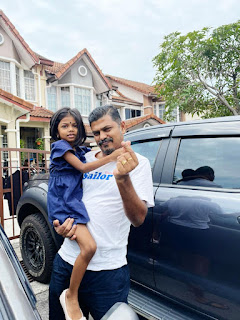My daughter started losing all her hair because of chemotheraphy to treat her ph+ B-Cell ALL. There is lot more reversible side effects comes together with chemotheraphy but hair lose is significant change. It was very difficult to watch her go through this, but I'm now doing all I can to make sure she face this with self-confidence.
After her introduction session Me and My daughter did one thing we wanted to do for very long time. We wish to donate our hair to cancer association to make a free wig . But we never this this will be the time when she diognosed with ph+ B-Cell ALL.
Before all her hair shed due to chemo, we look for hair donation association to donate our hair and a saloon which doing the hair cut following the hair donation requirement. We found this hair donation decision counterbalance the feelings of being out of control of the future. Plus, there's the added element of knowing what I'm "losing" is being "given" to someone else.
We are proud of our little girl in a such young age able to understand the power of giving and making differences in somebodies life. It feels absolutely amazing to be able to help someone and bring a smile on their face with small acts of kindness.
Few weeks into first cycle Mahiyaa began experiencing hair loss .I started to notice lots of hair everywhere in the house while sweeping the house and found handful hair on her pillow too. Even before Mahiyaa aware of how different she looked from those she knew and loved, I began to explain her what the chemotheraphy doing to her and why she is losing her hair. Me and my husband suggested her to bald the head to avoid the mess and pain of watching it drop so much. She agree for it and immediately we called barber to our house .
As a parents we have promised to walk in this journey together with her and wouldn't want her felt left alone in anyway and we opt ourself to bald our head too . Surprisingly her other siblings and her grandfather ,my dad Mr. Ganapathy don't want to be left out in the mission supporting Mahiyaa battling cancer and shaved their head too.
At this moment not only for her but it was total life changing moment for me. The society often associates femininity with long, flowing locks. I am one of them who embraced long hair and maintaining even its costly and time consuming. Now I would say it takes thick skin to rock bald head. Sometimes , as a women many times I felt not confident enough to face the society and my self esteem was sinking in one point but when I realize there is two little eyes are upon me I adjust my stern and ready to roll .
We don't want get a wig or bandana for her to cover the head as we believe and we want our kids to know everybody is beautiful in their own way and there is nothing to feel shy when we are different from others as beauty comes in all form and at the end what matters is that how we see ourself. I should admit here I do have self doubt but I imagine myself in her position and day by day I have become comfortable with having no hair.
Mahiyaa feels so much better looking at me and seeing me look the same as her boosted my spirit up. whenever people would see me a lot of people would just assume I having cancer so then I went into explaining, 'No, it's not me, it's my daughter and I'm doing this to support her.' And we kept our head bald following Mahiyaa hair growth. So it wasn't like it was just one time, it was an ongoing thing. This decision of balding gives me a chance to share my story and raise awareness about paediatric cancer when people ask me why my head is shaved and If I empower another woman to have the confidence to embrace her baldness during cancer treatment, that is just icing on the cake for me.
At this point, I genuinely happy and grateful to have wonderful family and friends around us to support us in all way. I'm so touched when my in laws family and my family created awareness to their children on their cousin's illness and they never made her feel different in anyway through this journey. At this point I also felt so thankful when Mahiyaa's school , Taylor’s International school management whereby they were so accommodating and supportive towards us. The wonderful teachers created awareness among her classmates on her condition. I'm so glad to know how the whole management put effort into forming a bully free society . We never felt alone.




